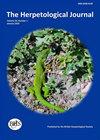The enigmatic palaeoecology and palaeobiogeography of the giant, horned, fossil turtles of Australasia: a review and reanalysis of the data
IF 1.1
4区 生物学
Q3 ZOOLOGY
引用次数: 1
Abstract
The distribution pattern of the bizarre Australasian giant, horned, fossil turtles of the clade Meiolaniidae has puzzled biogeographers since their discovery late in the nineteenth century. While their distribution suggests a Gondwanan origin, the lack of fossil evidence from key times and places has inhibited a better understanding of their dispersal pathways to Australia and the south-west Pacific islands in which their fossils have been found. Much palaeoecological speculation related to their dispersal capabilities, ranging from purely terrestrial to freshwater, estuarine, and saltwater lifestyles, has been proposed to explain their enigmatic presence across a wide swath of Oceania. Various lines of fossil, anatomical and ecological evidence now strongly suggest a highly terrestrial lifestyle, and we believe these traits, reinforced by an abundance of marine predators and ever-widening saltwater gaps between land areas during the Late Mesozoic and Tertiary, minimise the importance of saltwater dispersal as an explanation for the observed meiolaniid distribution pattern. Here we propose that the fragmentation of Gondwana provided the main dispersal vehicle for the meiolaniids and that land connections were also used to access suitable habitats and expand their range. The recently recognised continent of Zealandia, along with Australia, South America, and probably Antarctica, transported all known meiolaniid turtles to their present locations. However, ice cover on Antarctica, and the nearly total submergence of Zealandia in essence preclude the current likelihood of fossil discovery in these critical locations. The islands of New Caledonia, Tiga (in the Loyalty Islands), Walpole, and Lord Howe served as refugia for Zealandia meiolaniids as the continent submerged.澳大拉西亚巨型角龟化石神秘的古生态学和古生物地理学:数据回顾和再分析
自19世纪末发现奇异的澳大拉西亚巨型角龟化石以来,其分布模式一直困扰着生物地理学家。虽然它们的分布表明它们起源于冈瓦纳大陆,但由于缺乏关键时间和地点的化石证据,人们无法更好地了解它们传播到澳大利亚和发现化石的西南太平洋岛屿的途径。从纯陆地到淡水、河口和盐水的生活方式,人们提出了许多与它们的传播能力有关的古生态推测,以解释它们在大洋洲大片地区神秘存在的原因。各种化石、解剖学和生态学证据现在有力地表明了高度陆生的生活方式,我们相信,在中生代晚期和第三纪,大量的海洋食肉动物和陆地之间不断扩大的盐水间隙强化了这些特征,使盐水扩散作为对观测到的火山灰分布模式的解释的重要性降至最低。在这里,我们提出冈瓦纳大陆的碎片化为美拉尼西亚人提供了主要的传播媒介,陆地连接也被用来进入合适的栖息地并扩大其范围。最近被认可的新西兰大陆,以及澳大利亚、南美洲,可能还有南极洲,将所有已知的美奥蓝海龟运送到了现在的位置。然而,南极洲的冰盖和新西兰几乎完全被淹没,本质上排除了目前在这些关键地点发现化石的可能性。新喀里多尼亚岛、蒂加岛(洛亚尔群岛中)、沃波尔岛和豪勋爵岛在整个大陆被淹没时充当了新西兰人的避难所。
本文章由计算机程序翻译,如有差异,请以英文原文为准。
求助全文
约1分钟内获得全文
求助全文
来源期刊

Herpetological Journal
生物-动物学
CiteScore
2.40
自引率
10.00%
发文量
25
审稿时长
>12 weeks
期刊介绍:
The Herpetological Journal is the Society''s prestigious quarterly scientific journal.
 求助内容:
求助内容: 应助结果提醒方式:
应助结果提醒方式:


